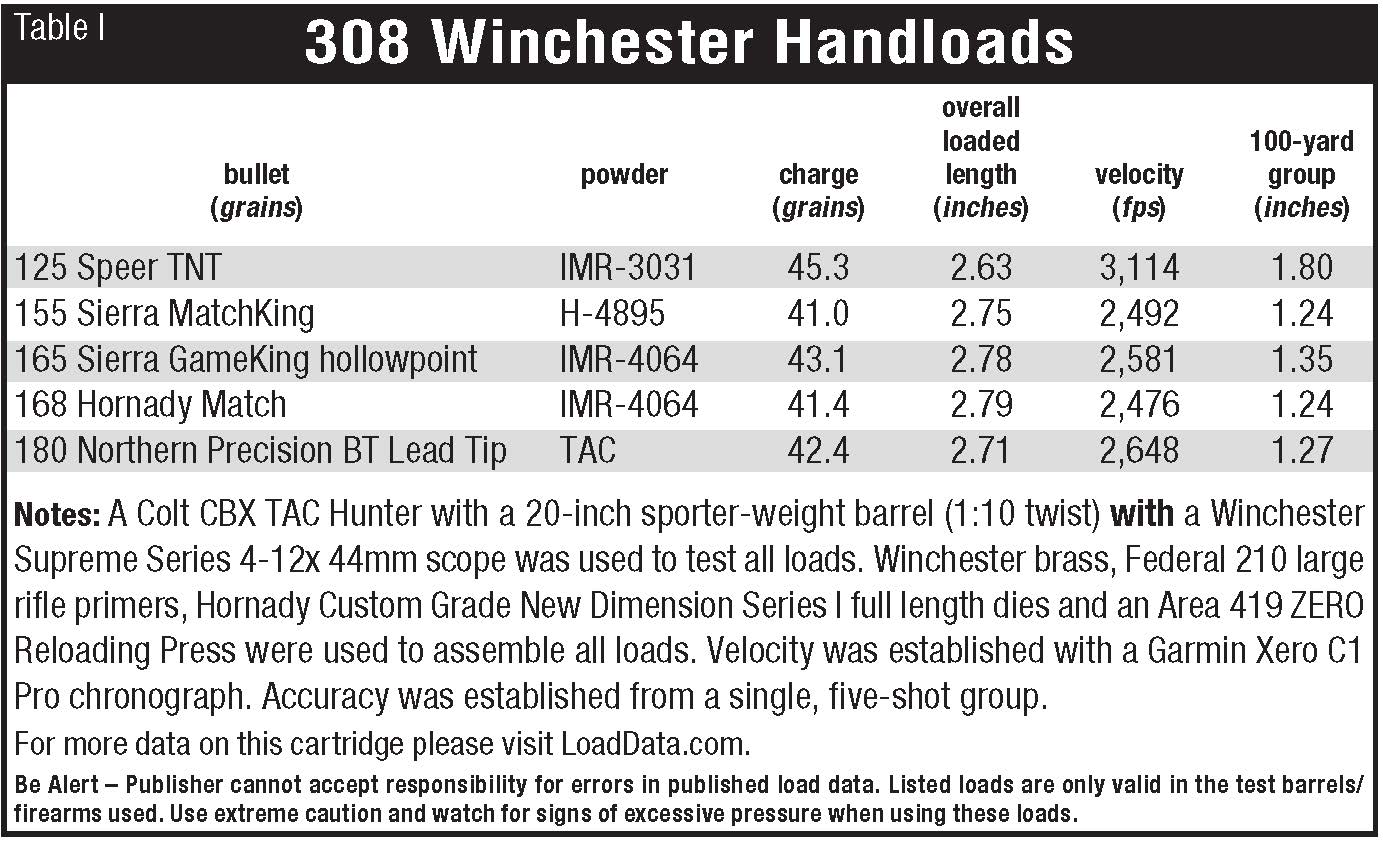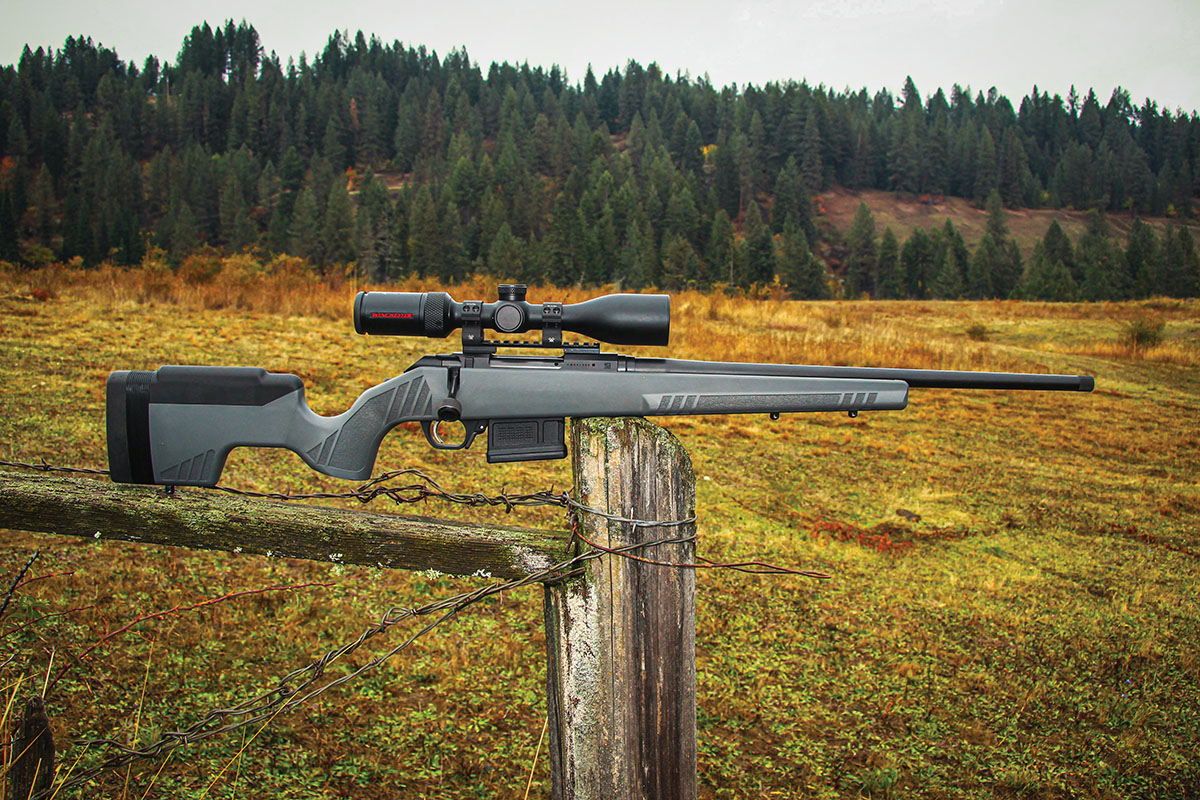
The Colt CBX TAC Hunter includes a sporter-weight 20-inch barrel and adjustable synthetic stock. It is chambered in 6.5 Creedmoor and 308 Winchester at this time.
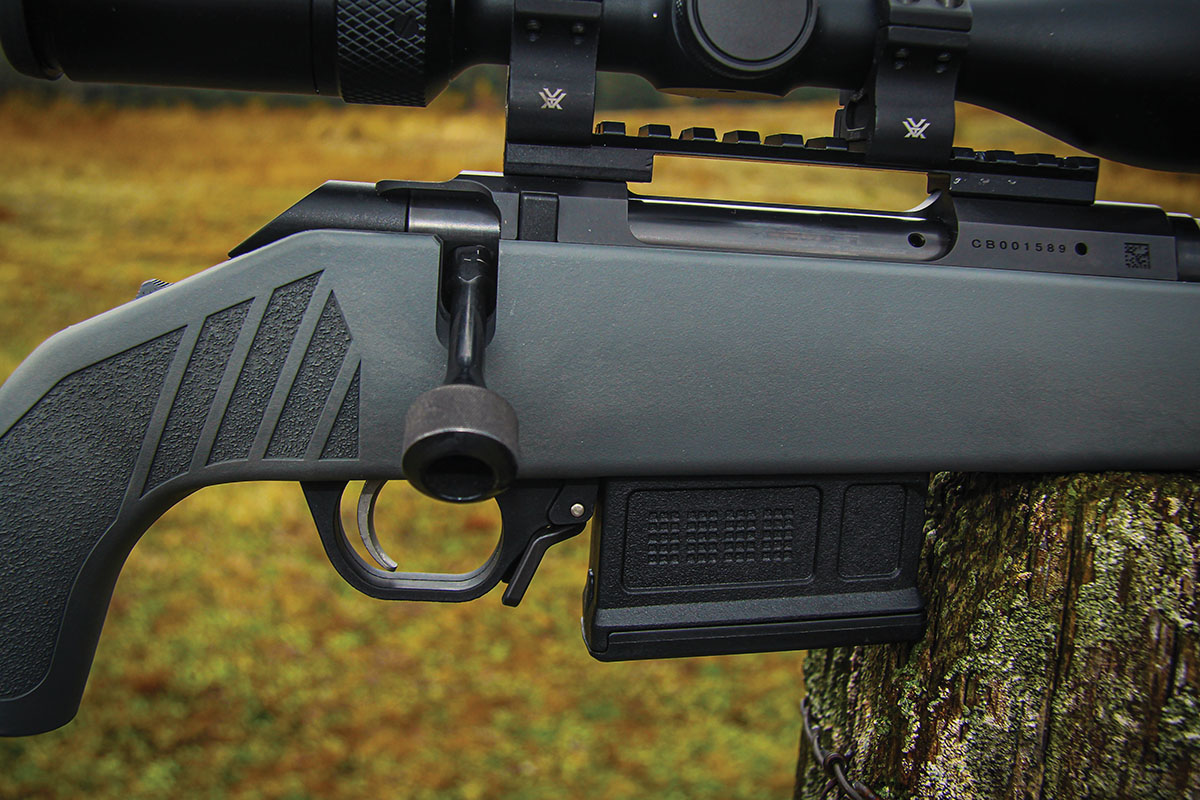
The Colt CBX TAC Hunter includes a detachable five-round magazine, an oversized bolt handle and a bolt-release button allowing unloading while the safety remains engaged.
Colt has a storied history in firearms manufacturing, a reputation based on their legendary revolvers that helped tame the West. Later, model 1911, pistols were carried by military personnel in at least four major conflicts. Then, AR-pattern rifles that have seen action in all U.S. military interventions from Vietnam onward. Yet when it comes to bolt-action rifles, Colt has traditionally subcontracted the work out to well-respected arms makers and then engraved the Colt name on them. At various times Colt rifles were manufactured by Jefferson Manufacturing Company of New Haven, Connecticut, using FN Mauser actions, Kodiak Arms utilizing Mauser and SAKO actions, Titan Defense (a company once owned by Colt), and of course, Sauer-made rifles manufactured by J.P. Sauer & Son of Germany and offered from 1973 to 1984.
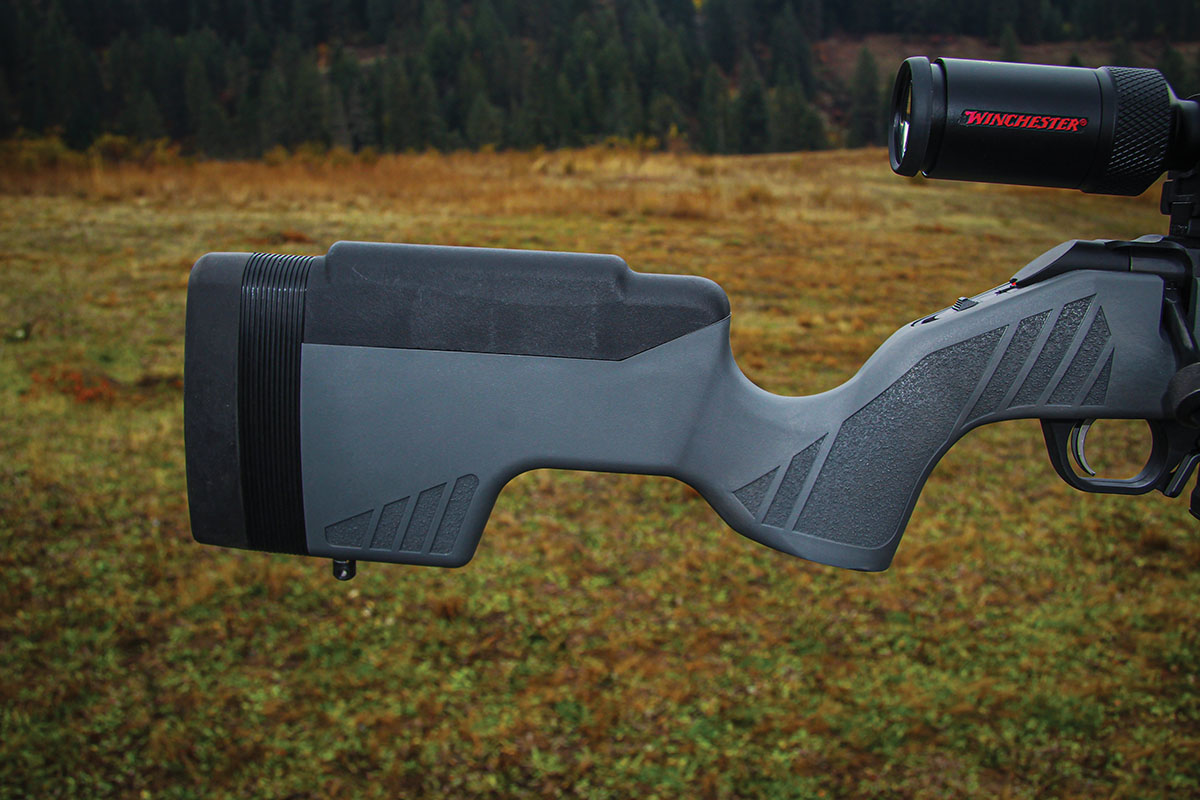
The stock is a tactical design including an adjustable length of pull, two comb-height options, a bag hook and a near-vertical grip. Aggressive stippling in the grip and forearm areas provides a firm grip.
In 2021, Colt was purchased by the Czech-based company CZ-USA, which explains why the Colt CBX TAC Hunter bolt-action rifle has its basis in the popular Model 600 rifle designed and manufactured by CZ-USA. Technically, the CBX series (a chassis-style CBX Precision Rifle model is also offered) is yet another iteration of the CZ Model 600. A fairly recent development from the Czech company. This isn’t exactly a Greek tragedy, as the Model 600s I have auditioned have proven excellent in every way, not excluding the all-important accuracy category.
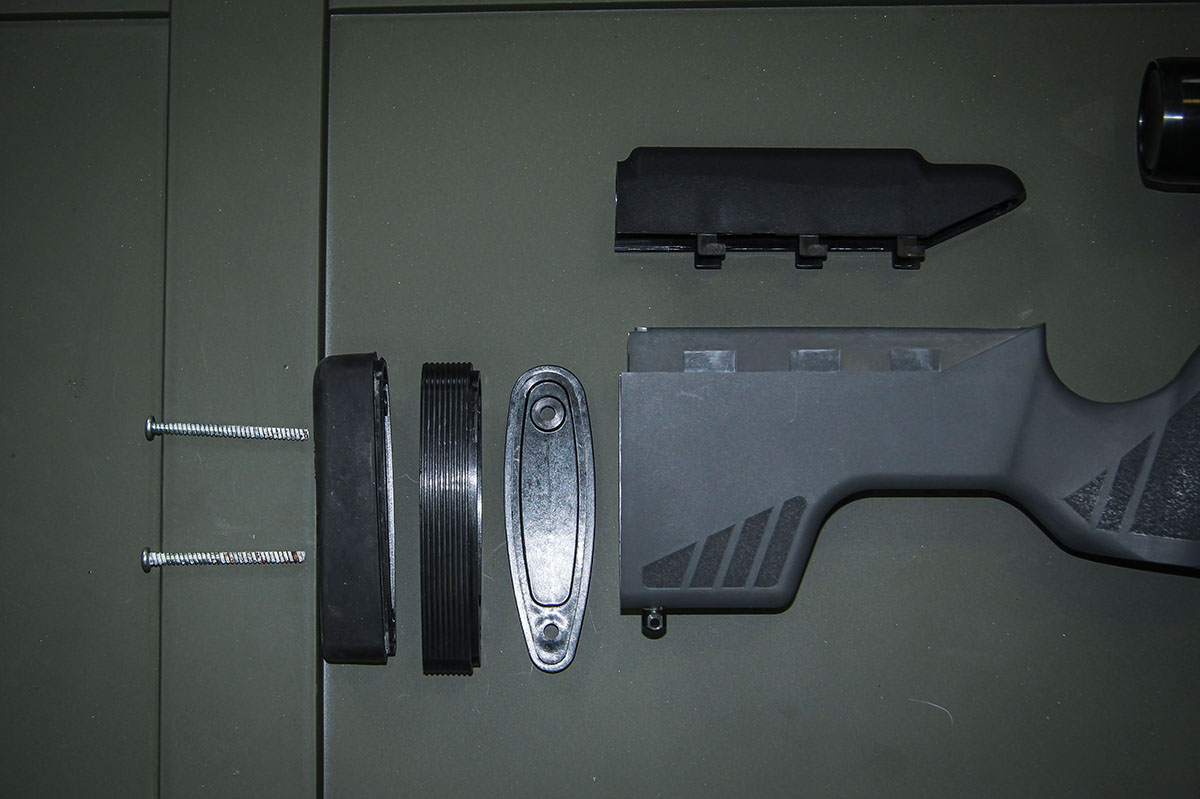
A blow-up of the parts of the buttstock length of pull adjustments. Two Phillip-head screws must be removed to change the length-of-pull and comb-height options.
The Colt CBX TAC Hunter and CBX Precision Rifle are offered in 6.5 Creedmoor and 308 Winchester. The TAC Hunter under discussion here holds a 20-inch carbon-steel, button-rifled barrel with 9⁄16x24 muzzle threads. The Creedmoor barrel receives a 1:8 rifling twist. The 308 Winchester tested here a 1:10 twist in a fairly light barrel measuring .64-inch just behind the muzzle threads. The TAC Hunter is bedded in a lightweight synthetic stock and weighs 7 pounds, 3.2 ounces unloaded. It includes a sub-MOA accuracy guarantee. Other selling points include a black nitride finish, quick 60-degree bolt cycling, user-adjustable trigger, and an ambidextrous magazine release for its five-round, detachable MagPull PMag magazine. Overall length is a tidy 39.88 inches, and MSRP is just south of a grand.
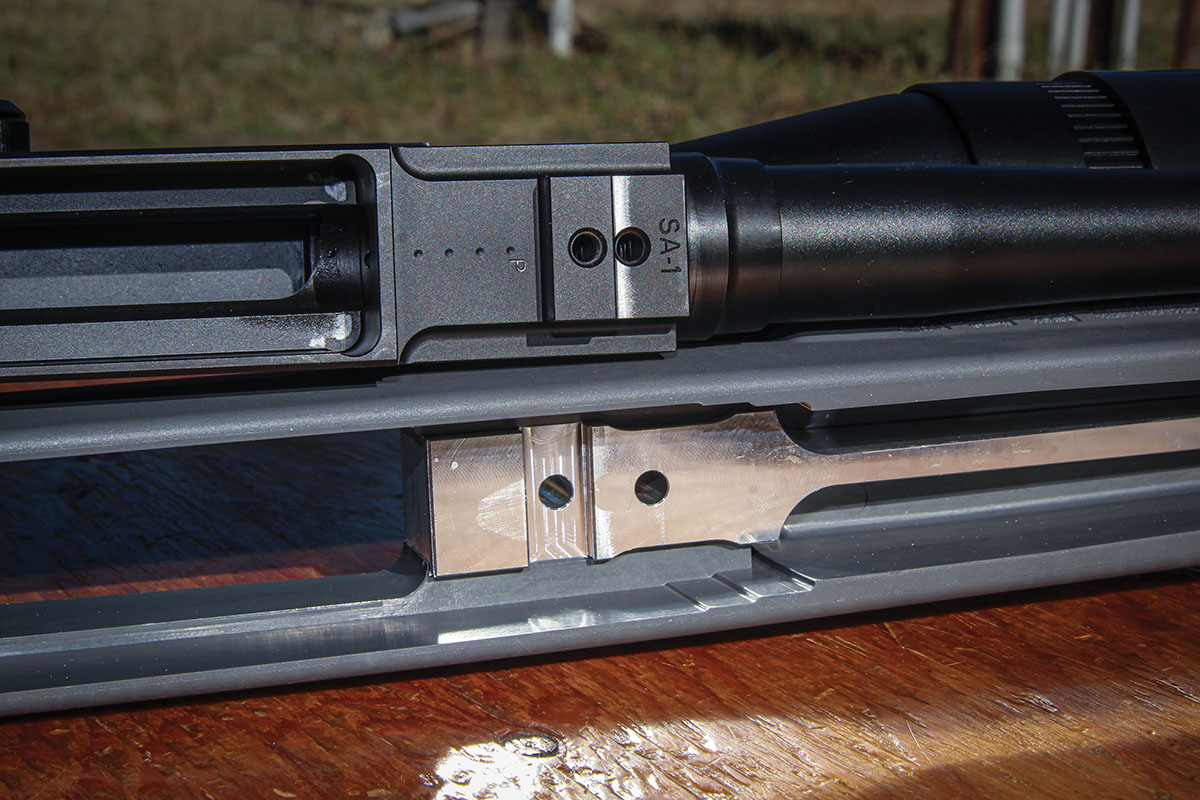
When disassembled, it is easy to see how the recoil lug system works: An integral lug is milled into the action and fitted into a milled slot in the aluminum bedding block.
While the CBX’s action is obviously Model 600-inspired, I see some marked departures from the CZ actions, I worked with in the past. Some features remain unchanged, like a bolt-lug arrangement sporting three rows of two lugs (thus the 60-degree throw) instead of the traditional two-lug system used on past CZ models, and an M16-style extractor instead of the external claw extractor blade of yore. The modular bolt includes lug sets sitting at 10, 2, and 6 o’clock, and the bottom of the bolt face is open to accept cartridge rims. The lower lug group efficiently strips rounds from the double-stack magazine and coaxes them up the raceway and into the chamber. It is a
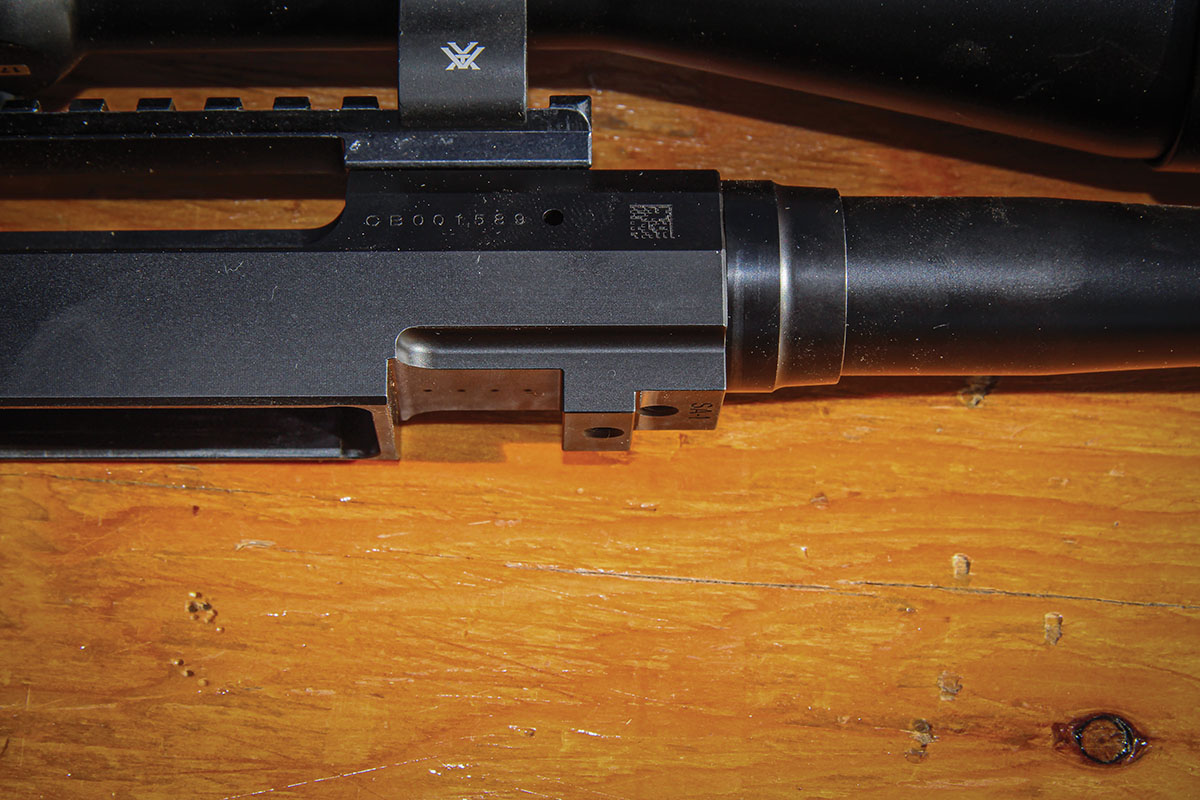
The recoil lug, milled as an integral part of the CZ Model 600-style action.
close approximation of a controlled-feed system without the bulky side blade. However, cartridge control isn’t fully initiated until the bolt moves completely forward and the extractor fully engages the case rim. The plunger ejector is mechanical, not spring-loaded, so it doesn’t impart pressure on the cartridge while it is in the chamber. Feeding and cycling are smooth and reliable. The magazine can be easily topped off while firmly installed in the action/stock – complicated only slightly by a one-piece Pic rail.
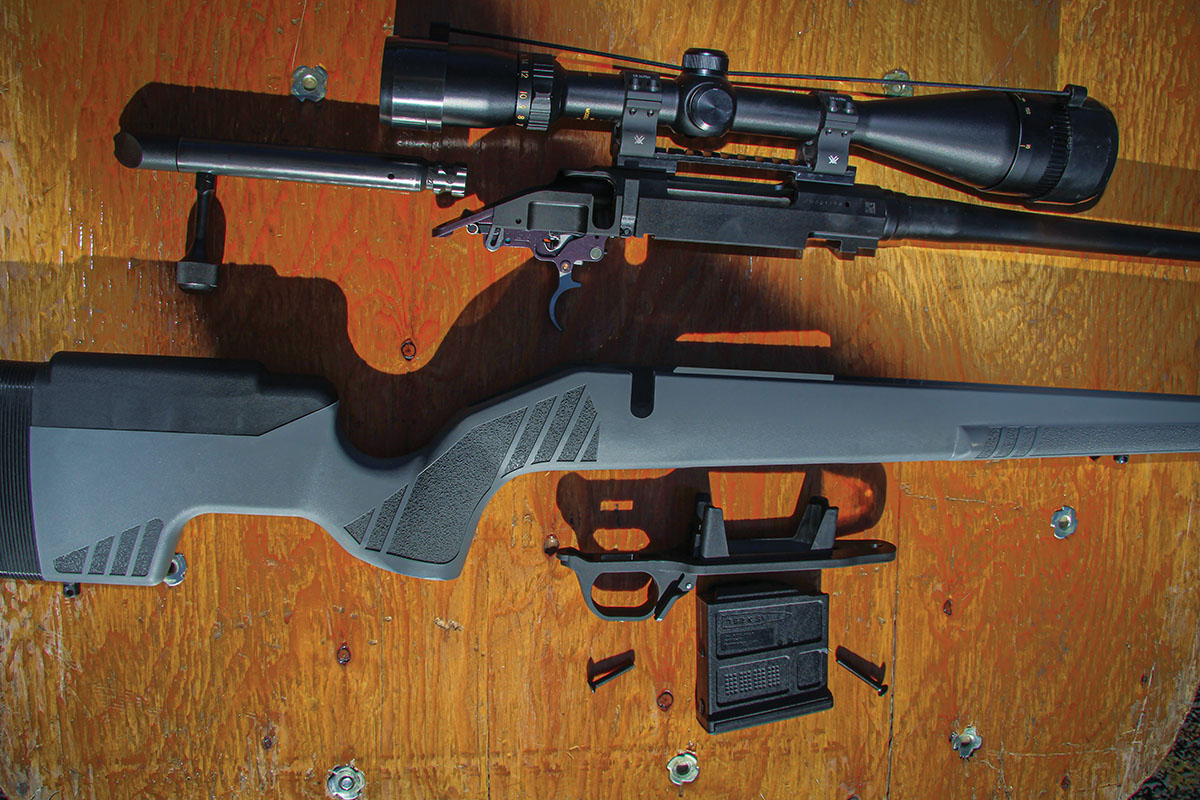
A blow-up of the Colt CBX TAC Hunter’s major parts groups.
The bolt lugs lock directly into the barrel when in full battery, allowing all chamber pressure to be fully contained within the barrel. This also closely controls lug abutment in relation to the chamber to ensure proper head-spacing and exceptional concentricity between the chamber and bore to boost accuracy potential. A plastic tool is supplied for bolt disassembly for cleaning. A red tab appears at the rear of the bolt shroud when the firing pin is cocked. The finely knurled and oversized bolt head, combined with the short 60-degree cycling, provided fast and slick cycling.
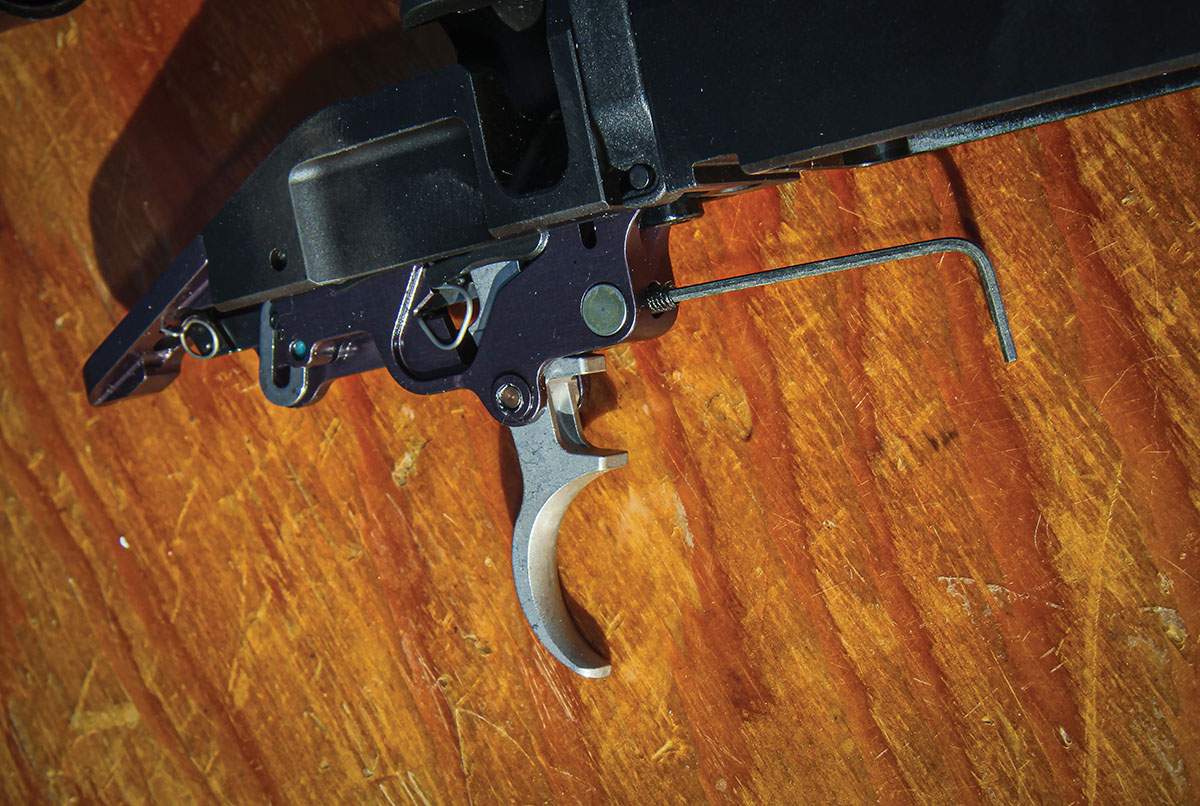
The Colt includes the type of user-adjustable trigger that CZ-USA has made famous. Adjustment requires pulling the action from the stock.
The CBX receiver includes the Model 600’s square bottom, side and top flats. This increases rigidity over typical round actions. The dual action-anchoring screws engage an ample amount of flat bedding surface beneath the tenon, reducing stress and torque on the action. The rear action screw engages a flat just forward of the trigger (not the typical rear receiver tang placement), producing less chance of “bending” the action while also ensuring lots of anchoring metal. Where I noted a conspicuous change from other Model 600 actions I’ve tested is in the recoil-lug system. The CBX action includes an integral recoil lug (instead of two lug slots and corresponding lugs embedded into the stock, like the CZ Model 600 Range I tested before). This slots into an aluminum bedding block, the aluminum extending forward and into the forearm to stiffen the forearm and serve as the thread base for the two forward sling studs. The system creates exceptional stability after tightening the two Torx-head action screws.
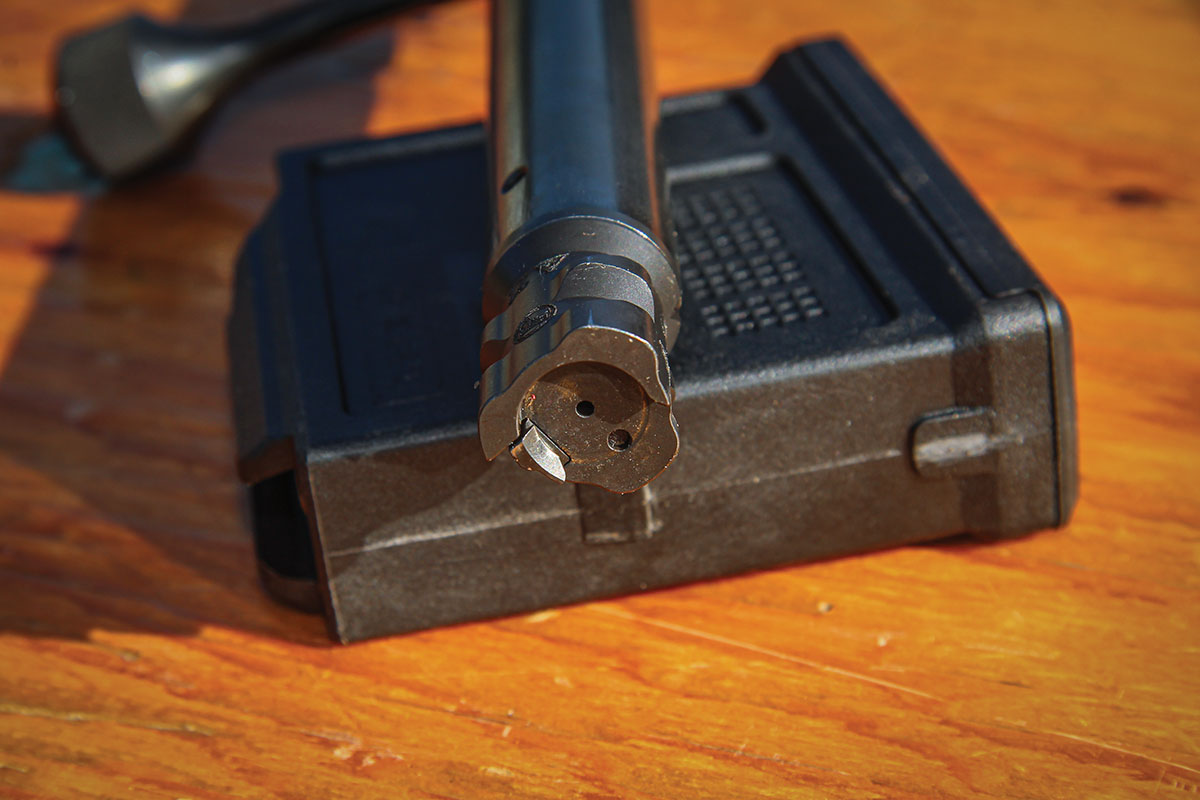
The bolt of the Colt CBX TAC Hunter closely mirrors that found on the CZ-USA Model 600. The open bottom and ejector lip act as a sort of controlled feed system.
The tactical-style CBX TAC Hunter is bedded in a molded grey polymer stock, including the aforementioned aluminum bedding block. Stippling on the grip and forearm areas provides a firm purchase, even in wet or icy weather or while wearing gloves. The forearm bottom is flared to create a wider base to set on a bag rest, and the grip is essentially vertical with some amount of palm swell. Two sling studs are mounted forward, with one to the rear. A bag cutout is located at the bottom of the butt,
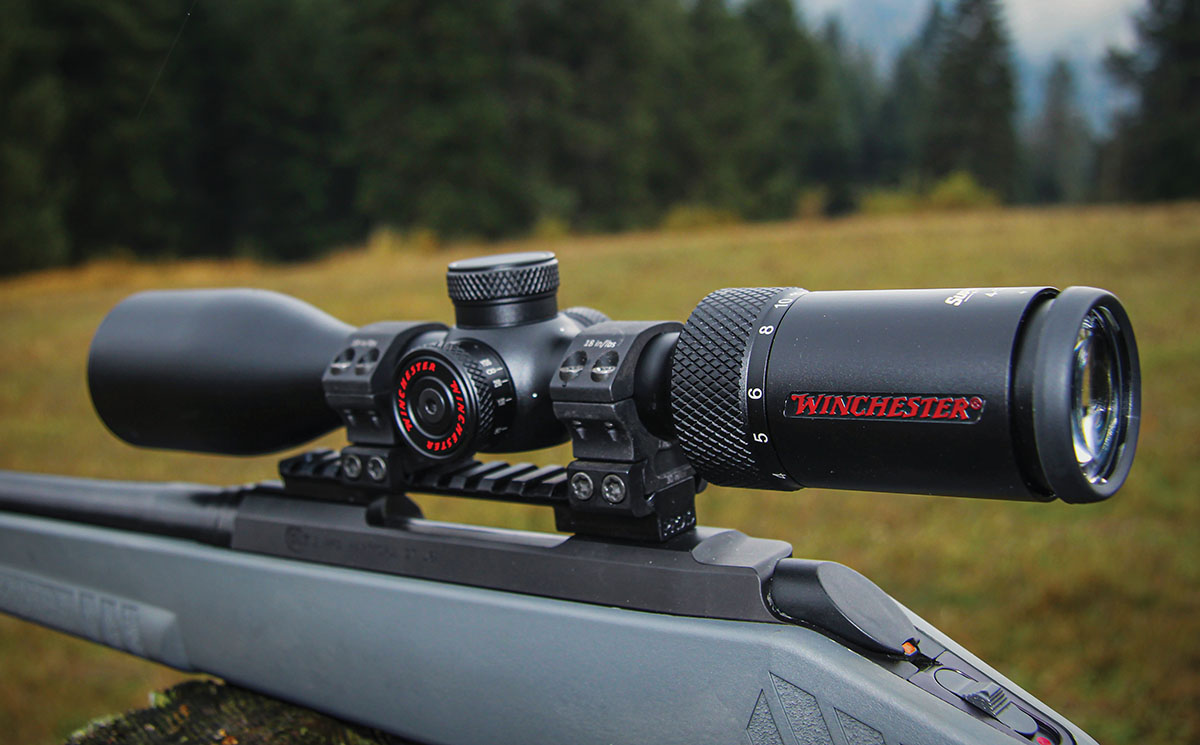
The test rifle was topped with a new Winchester Supreme Series 4-12x 44mm riflescope in 1-inch steel .95-inch high four-screw rings. The optic is clear and solidly made but includes a fairly chunky reticle.
just behind the Colt-logoed grip cap. Two Phillips-head screws can be removed (with a small amount of effort) to withdraw the soft rubber recoil pad, then allowing the provided stackable spacers to be added or subtracted as needed to customize the length of pull. Removing the recoil pad also allows swapping between the two provided comb pieces, one straight and another a ½-inch higher. The trigger guard and “bottom metal” are molded from a polymer material. The barrel is thoroughly floated.
In all honesty, I found the CBX TAC Hunter’s comb to be a bit too narrow and borderline uncomfortable. The only gripe I have against an otherwise ergonomic stock.
The CBX trigger mirrors past CZ experiences, proving to be easily adjustable (after removing the action from the stock to access a set screw on the front of the trigger housing), impressively smooth and crisp. Out of the box it broke at 4 pounds, but can be tweaked down to 2.5 pounds if desired. The safety is a two-position tang design, pulled back to prevent firing and locking the bolt closed, pushed forward to expose a red dot and to fire. A push-down tab located on the right-rear corner of the receiver allows unlocking the bolt to unload the chamber without disengaging the safety, while also allowing bolt removal for cleaning. The ambidextrous mag release is a spring-loaded paddle located at the front of the polymer trigger guard. This is pushed forward to unlock the mag, but the PMag easily clicked back into place with very little pressure.
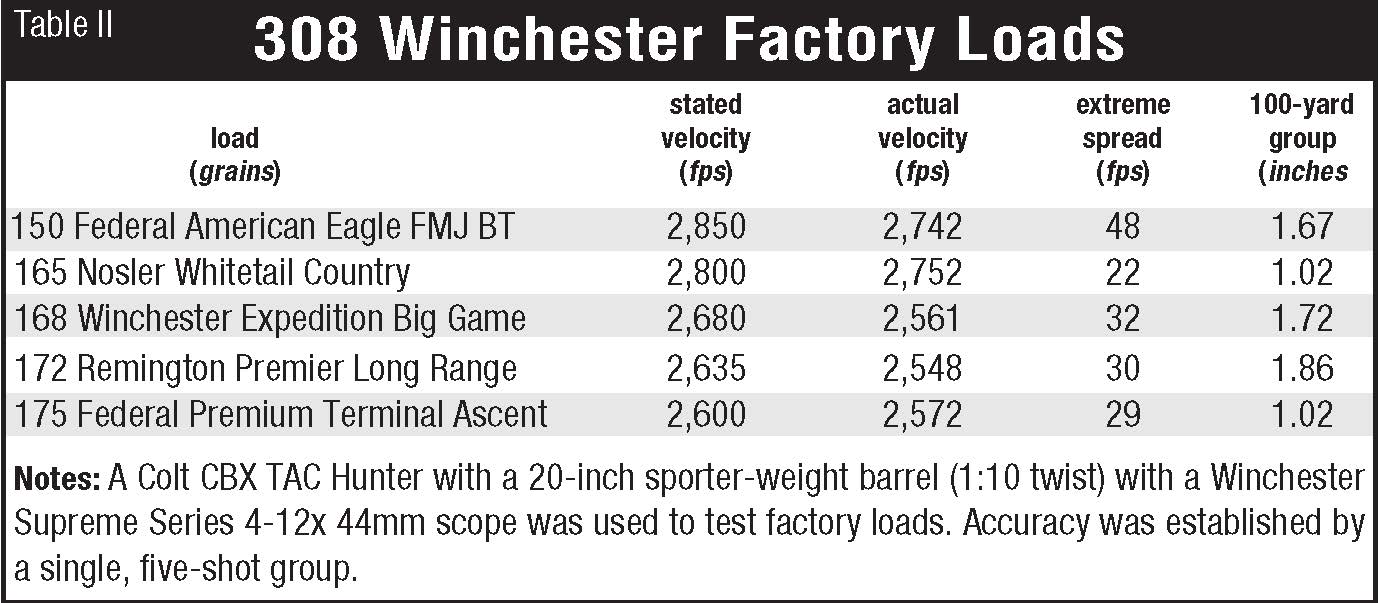
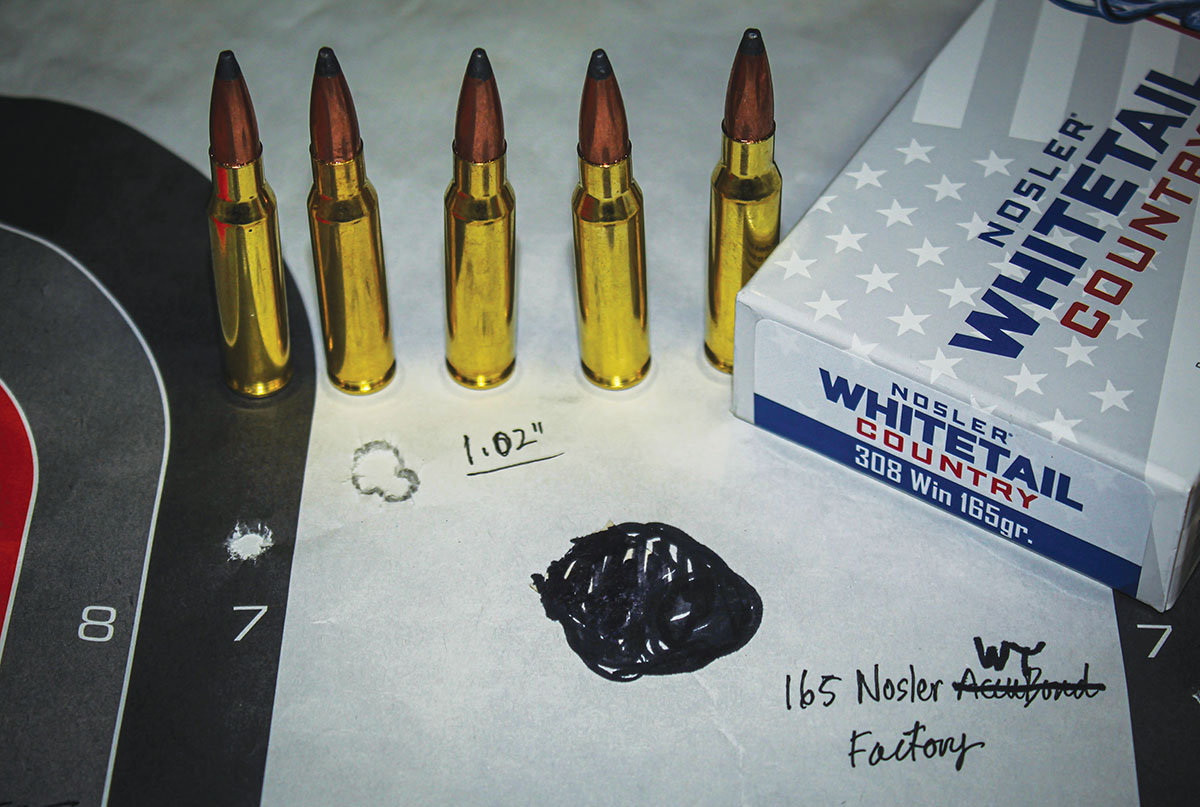
Nosler’s new Whitetail Country ammunition loaded with a 165-grain solid base/softpoint bullet shot one of best groups of the test, placing five shots into 1.02 inches at 100 yards with a velocity of 2,752 fps.
The CBX includes four in-line taps to accept Remington Model 700-pattern scope bases, short action in this case. To that point, I have a bone to pick with Colt. Having tested a couple of similarly equipped CZ Model 600 rifles, I had on hand an aluminum UTG 20-MOA Picatinny rail and Warne two-piece 20-MOA steel bases. Everything lined up perfectly, but I soon discovered the taps had been enlarged, so the previous mounting screws dropped right in. A thorough web search failed to reveal a solution. Scrounging the proper screws, I was then forced to carefully enlarge the base holes in the Pic rail to mount a scope. Increased thread engagement is certainly welcomed, but Colt might want to inform scope-base manufacturers of this situation or, better yet, simply provide pre-installed bases with each rifle.
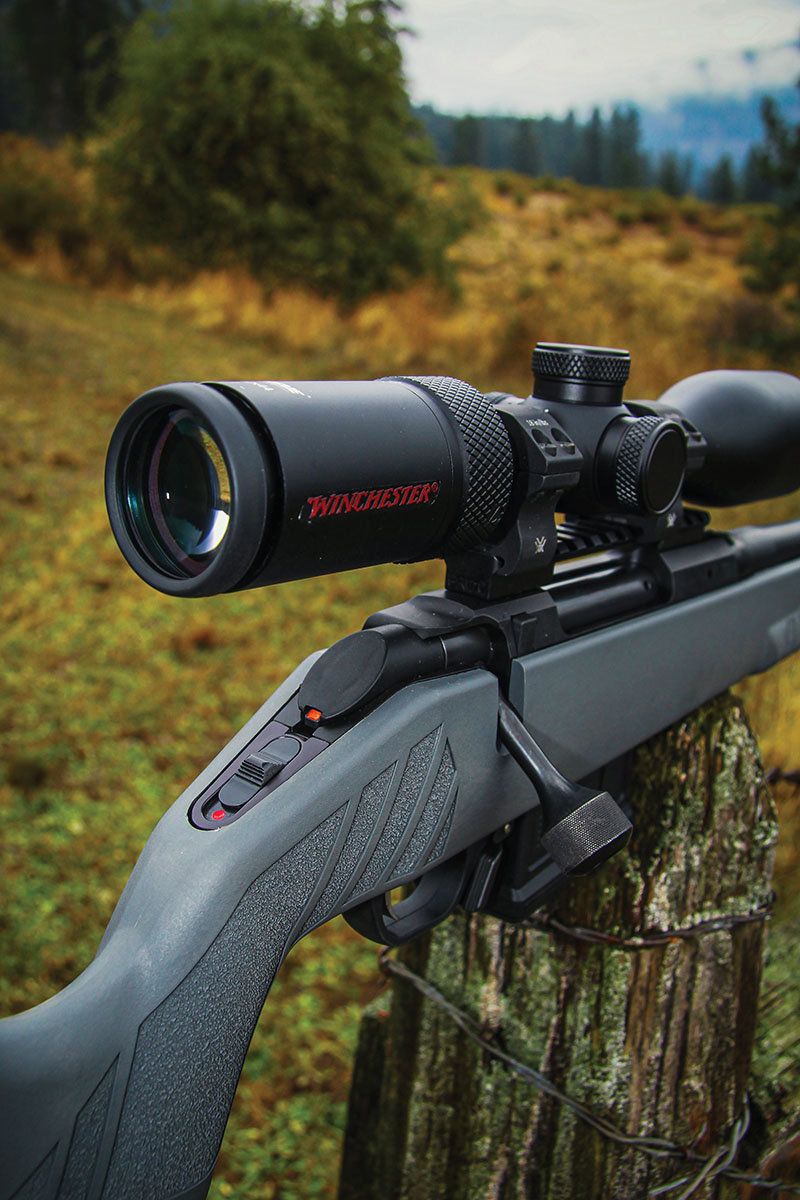
The safety on the Colt is a simple two-position tang design, with the bolt locked while on safe. A red tab appears at the rear of the bolt shroud when the firing pin is cocked.
With the base issue solved, I mounted a new Winchester Supreme Series 4-12x 44mm riflescope in 1-inch steel .95-inch high four-screw rings. This aligned my eye perfectly behind the scope when combined with the Colt’s higher interchangeable comb option. This is an impressively compact optic with covered MOA turrets and side parallax adjustment free of plastic parts. It included remarkably clear glass and positive controls; my only nitpick was the fairly chunky reticle.
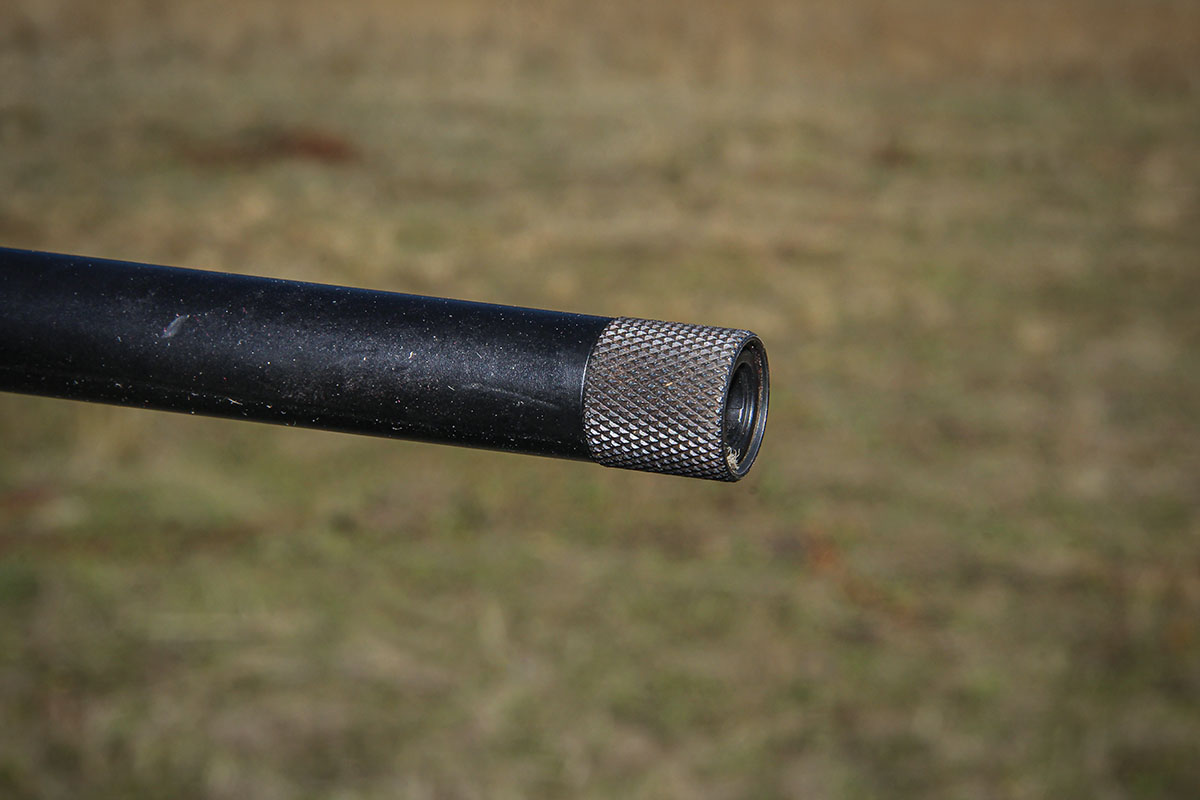
The sporter-weight barrel is threaded 9⁄16x24 to accept a brake or suppressor. A knurled thread protector is supplied.
Colt chose the 6.5 Creedmoor and 308 Winchester to chamber in the CBX series because this is what rifle manufacturers do today, as if by federal directive punishable by death. The 308 Win is inherently accurate in the true sense of the oft-abused term, good enough for most North American big-game duties, and loaded with a huge variety of ammunition.
Shooting began with a variety of factory rounds, including American Eagle 150-grain FMJ BT plinker rounds; Nosler Trophy Grade 165-grain AccuBond; Winchester 168-grain Expedition Big Game loaded with Nosler AccuBond Long Range bullets; Remington 172-grain Premier Long Range 172-grain Speer Impact BT; and Federal Premium 175-grain Terminal Ascent big-game loads. Next I tried some random handloads, including Speer’s 125-grain TNT over 45.3 grains of IMR-3031; Sierra’s 150-grain MatchKing over 41 grains of Hodgdon 4895; Sierra’s 165-grain GameKing HP using 43.1 grains of IMR-4064; Hornady’s 168-grain HPBT Match and 41.4 grains of IMR-4064; and Northern Precision’s 180-grain BT Lead Tip paired with 42.4 grains of Ramshot TAC.
The test rifle struggled to meet the 1-MOA guarantee, though I suspect higher magnification and especially thinner cross-hairs would have helped that situation. It must also be noted the rifle shot fantastic three-shot groups, groups opening on the fourth and fifth shots.
The American Eagle, Winchester and Remington factory ammo groups were nothing to write home about. Nosler’s spanking-new 165-grain Whitetail Country ammunition impressed, grouping into a near 1-MOA cluster with five shots at 100 yards, hitting 2,752 fps from the 20-inch tube and showing an extreme velocity spread of just 22 fps. This ammo includes a lead-tip, boattail Solid Base bullet that will appear familiar to those who shot those fine slugs before the appearance of the Ballistic Tip. They provide consistent mushrooms, whether shot from 50 or 400 yards. Federal Premium’s 175-grain Terminal Ascent load matched that accuracy, a slug including a bonded-lead core up front and solid copper base wrapped around a high ballistic coefficient. I would trust these loads on elk or large African plains game.
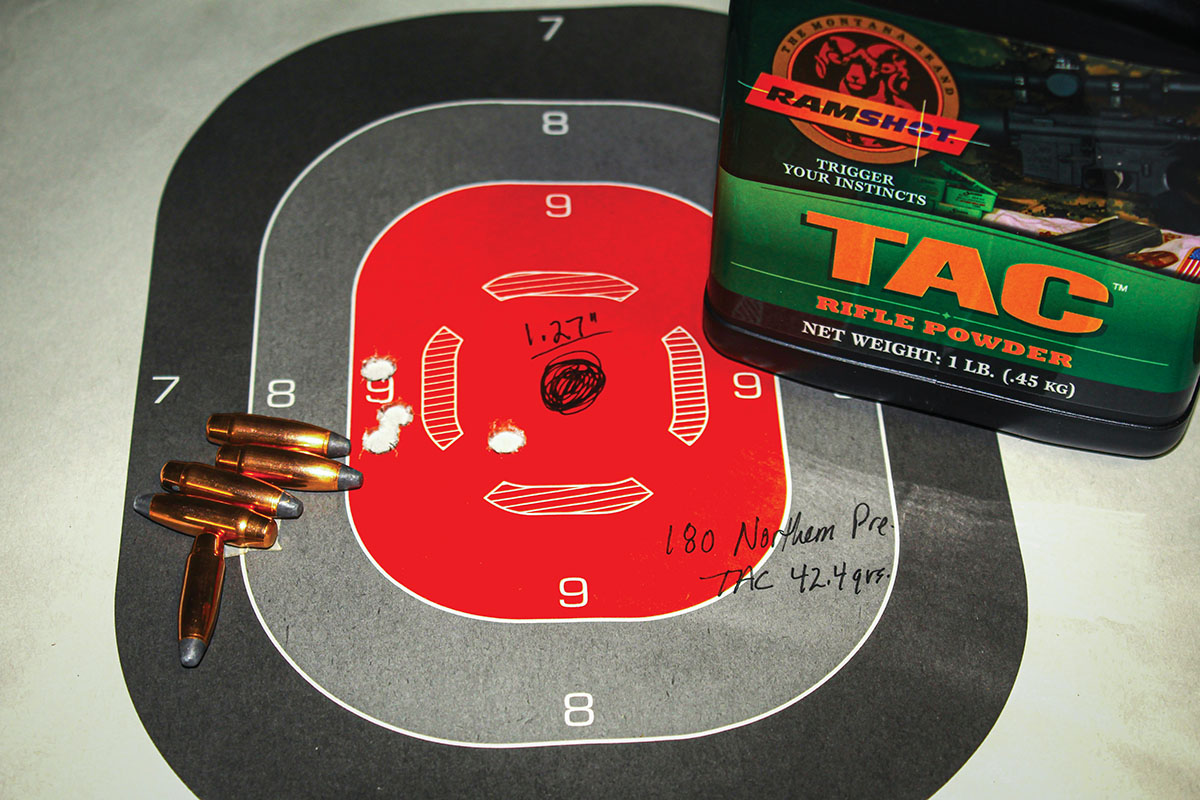
Northern Precision’s 180-grain Soft Point Boattail produced an excellent hunting load when combined with 42.4 grains of Ramshot TAC, printing into less than 1½ inches and leaving the muzzle at a hard-hitting 2,648 fps without any undue pressure signs.
Aside from the 125-grain Speer TNT varmint load, handloads provided remarkably consistent sub-1½-inch accuracy from 150 to 180 grains. A 41-grain charge of Hodgdon 4895 beneath Sierra’s 150-grain MatchKing grouped into 1.24 inches at 2,492 fps. Sierra’s 165-grain GameKing HP would make a fine big-game load, 43.1 grains of IMR-4064 running up to 2,581 fps and grouping well under 1 ½ inches. Hornady’s 168-grain BTHP Match seated over 41.4 grains of IMR-4064 tied for best handload group, printing five shots into 1.24 inches at 2,476 fps. Northern Precision’s 180-grain BT Lead Tip (this one non-bonded, a bonded version also offered) did well paired with 42.4 grains of Ramshot TAC, not only producing a group of 1.27 inches but pushing that heavyweight bullet to a hard-hitting 2,648 fps without pressure signs and very low extreme velocity spreads.
The CBX TAC Hunter rifle carries an apt name, as it is certainly a hunting/tactical hybrid that would be as at home in the treestand or mountains as on the range banging distant steel. It is handy and easy toting and adaptable to all sizes of shooters and optics. Stock fit is subjective, so while the comb style was not to my liking (a bit narrow for comfort), another shooter may find it just right. That is something to determine at the sales counter. The rifle certainly offers ample hunting accuracy, but I would be curious to see how an optic in the 6-18x 50mm range holding a finer reticle would affect groups. All told, though, I’d confidently hunt with this rifle tomorrow morning.


















